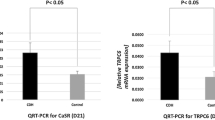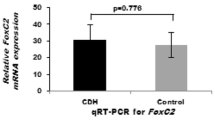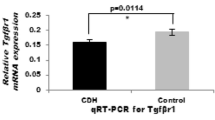Abstract
Aim of the study
The high morbidity and mortality in congenital diaphragmatic hernia (CDH) is attributed to pulmonary hypoplasia and persistent pulmonary hypertension (PH). PH is characterized by increased pulmonary artery smooth muscle cell (SMC) proliferation, suppressed apoptosis as well as endothelial dysfunction. Krüppel-like factor 5 (KLF5) belongs to a family of transcription factors that has diverse functions during cell differentiation and embryonic development. KLF5 is preferentially expressed in proliferating SMCs but reduced in differentiated cells. KLF5 induces the expression of Survivin, a 16.5 kDa protein overexpressed in almost all malignancies but hardly detected in normal differentiated tissues. Survivin has been shown to inhibit apoptosis, promote cell proliferation, and enhance angiogenesis. Recent studies have implicated activation of KLF5 and Survivin in the pathogenesis of human and experimental PH. We designed this study to investigate the hypothesis that KLF5 and Survivin expression are increased in nitrofen-induced CDH.
Methods
Pregnant rats were exposed to nitrofen or vehicle on D9. Fetuses were sacrificed on D21 and divided into nitrofen (n = 16) and control group (n = 16). Quantitative real-time PCR, western blotting, and confocal immunofluorescence were performed to determine pulmonary gene expression levels and protein expression of KLF5, Survivin, and phosphorylated Survivin (p-Survivin).
Main results
Confocal microscopy revealed markedly increased pulmonary vascular KLF5 and p-Survivin expression in lungs of nitrofen-exposed fetuses compared to controls. These results were confirmed by western blotting, showing increased pulmonary expression of KLF5 and p-Survivin. Furthermore, the relative pulmonary gene expressions of KLF5 and Survivin were significantly increased in the CDH group compared to controls (p < 0.005 rsp. p < 0.01).
Conclusion
This study provides striking evidence of increased gene and protein expression of KLF5 and activated Survivin in the pulmonary vasculature of nitrofen-induced CDH, suggesting that increased expression of KLF5 may activate p-Survivin expression and play an important role in the pathogenesis of PH in nitrofen-induced CDH.


Similar content being viewed by others
References
Keijzer R, Puri P (2010) Congenital diaphragmatic hernia. Semin Pediatr Surg 19:180–185. doi:10.1053/j.sempedsurg.2010.03.001
Luong C, Rey-Perra J, Vadivel A et al (2011) Antenatal sildenafil treatment attenuates pulmonary hypertension in experimental congenital diaphragmatic hernia. Circulation 123:2120–2131. doi:10.1161/CIRCULATIONAHA.108.845909
Wu J, Yu Z, Su D (2014) BMP4 protects rat pulmonary arterial smooth muscle cells from apoptosis by PI3K/AKT/Smad1/5/8 signaling. Int J Mol Sci 15:13738–13754. doi:10.3390/ijms150813738
Shindo T, Manabe I, Fukushima Y et al (2002) Krüppel-like zinc-finger transcription factor KLF5/BTEB2 is a target for angiotensin II signaling and an essential regulator of cardiovascular remodeling. Nat Med. doi:10.1038/nm738
Courboulin A, Tremblay VL, Barrier M et al (2011) Krüppel-like factor 5 contributes to pulmonary artery smooth muscle proliferation and resistance to apoptosis in human pulmonary arterial hypertension. Respir Res 12:128. doi:10.1186/1465-9921-12-128
Nagai R, Suzuki T, Aizawa K et al (2005) Significance of the transcription factor KLF5 in cardiovascular remodeling. J Thromb Haemost 3:1569–1576. doi:10.1111/j.1538-7836.2005.01366.x
Dong J-T, Chen C (2009) Essential role of KLF5 transcription factor in cell proliferation and differentiation and its implications for human diseases. Cell Mol Life Sci 66:2691–2706. doi:10.1007/s00018-009-0045-z
Zhu N, Gu L, Findley HW et al (2006) KLF5 Interacts with p53 in regulating survivin expression in acute lymphoblastic leukemia. J Biol Chem 281:14711–14718. doi:10.1074/jbc.M513810200
McMurtry MS (2005) Gene therapy targeting survivin selectively induces pulmonary vascular apoptosis and reverses pulmonary arterial hypertension. J Clin Invest 115:1479–1491. doi:10.1172/JCI23203
Hofmann AD, Friedmacher F, Takahashi H et al (2013) Decreased apelin and apelin-receptor expression in the pulmonary vasculature of nitrofen-induced congenital diaphragmatic hernia. Pediatr Surg Int 30:197–203. doi:10.1007/s00383-013-3450-1
Andersen CU, Hilberg O, Mellemkjær S et al (2011) Apelin and pulmonary hypertension. Pulm Circ 1:334–346. doi:10.4103/2045-8932.87299
Hofmann A, Gosemann J-H, Takahashi T et al (2014) Imbalance of caveolin-1 and eNOS expression in the pulmonary vasculature of experimental diaphragmatic hernia. Birth Defects Res B Dev Reprod Toxicol 101:341–346. doi:10.1002/bdrb.21117
Runo JR, Loyd JE (2003) Primary pulmonary hypertension. Lancet 361:1533–1544. doi:10.1016/S0140-6736(03)13167-4
Gosemann J-H, Friedmacher F, Fujiwara N et al (2013) Disruption of the bone morphogenetic protein receptor 2 pathway in nitrofen-induced congenital diaphragmatic hernia. Birth Defects Res B Dev Reprod Toxicol 98:304–309. doi:10.1002/bdrb.21065
Gurbanov E, Shiliang X (2006) The key role of apoptosis in the pathogenesis and treatment of pulmonary hypertension. Eur J Cardiothorac Surg 30:499–507. doi:10.1016/j.ejcts.2006.05.026
Montani D, Chaumais M-C, Savale L et al (2009) Phosphodiesterase type 5 inhibitors in pulmonary arterial hypertension. Adv Therapy 26:813–825. doi:10.1007/s12325-009-0064-z
Keegan A, Morecroft I, Smillie D et al (2001) Contribution of the 5-HT(1B) receptor to hypoxia-induced pulmonary hypertension: converging evidence using 5-HT(1B)-receptor knockout mice and the 5-HT(1B/1D)-receptor antagonist GR127935. Circ Res 89:1231–1239
Guignabert C, Raffestin B, Benferhat R et al (2005) Serotonin transporter inhibition prevents and reverses monocrotaline-induced pulmonary hypertension in rats. Circulation 111:2812–2819. doi:10.1161/CIRCULATIONAHA.104.524926
Liu R, Zheng H-Q, Zhou Z et al (2009) KLF5 promotes breast cell survival partially through fibroblast growth factor-binding protein 1-pERK-mediated Dual specificity MKP-1 protein phosphorylation and stabilization. J Biol Chem 284:16791–16798. doi:10.1074/jbc.M808919200
Salvesen GS, Duckett CS (2002) IAP proteins: blocking the road to death’s door. Nat Rev Mol Cell Biol 3:401–410. doi:10.1038/nrm830
Meloche J, Courchesne A, Barrier M et al (2013) Critical role for the advanced glycation end-products receptor in pulmonary arterial hypertension etiology. J Am Heart Assoc 2:e005157–e005157. doi:10.1161/JAHA.112.005157
Waksman JC (2008) Cardiovascular risk of rosiglitazone: another perspective. J Pharm Pharmacol 60:1573–1582. doi:10.1211/jpp.60.12.0002
Author information
Authors and Affiliations
Corresponding author
Rights and permissions
About this article
Cite this article
Hofmann, A.D., Takahashi, T., Duess, J.W. et al. Increased pulmonary vascular expression of Krüppel-like factor 5 and activated survivin in experimental congenital diaphragmatic hernia. Pediatr Surg Int 30, 1191–1197 (2014). https://doi.org/10.1007/s00383-014-3606-7
Accepted:
Published:
Issue Date:
DOI: https://doi.org/10.1007/s00383-014-3606-7




